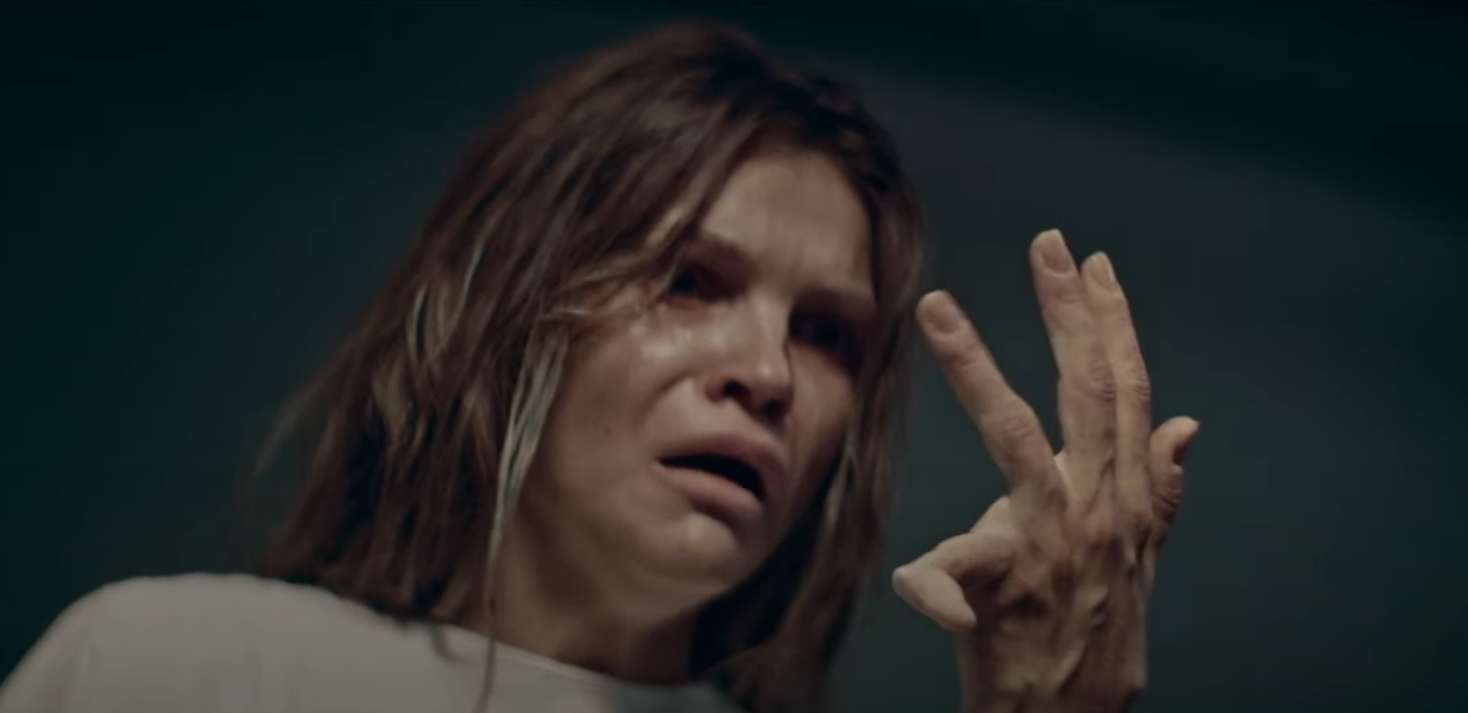Superdeep, written and directed by Arseny Syuhin, feels like a cross between John Carpenter’s The Thing, Joe Dante’s The Hole, and Neil Blomkamp’s Zygote. Milena Radulovic, who plays Anna, has the tenacity of R. J. MacReady, the intelligence of Agent Starling, and the bravery of Ripley. Superdeep as a film may feel long for a two-hour film, and the editing could have been better. Having said that, considering the film’s modest budget, it is nevertheless a masterpiece.
The practical effects are on par with, if not better than, films with ten times the budget, in which green screens are shoved right in our faces thanks to CGI. This one had very little VFX and was nearly exclusively reliant on actual effects. One could even say that the completed monstrosity would have made H. R. Giger, the Xenomorph maestro, proud.
Superdeep is based on a true story of a mystery disease caused by a fungus that was discovered 12000 meters underground at the Kola Superdeep Borehole in Russia’s Pechengsky District. Anna, played by Milena Radulovic, is an epidemiologist who is trapped in the heart of an infectious outbreak deep beneath the Earth’s surface and must do everything she can to prevent it from reaching the surface. However, the cellular parasite is quite potent and can cause human mutations. Will Anna and her companions be successful? Let us get right to the point and take a deep dive into this Russian horror movie.
In 1984, a Russian epidemiologist named Anna Fedorova was heading the MX 23 Project. She approved the human tests of the vaccine MX 23 by deliberately skipping the preliminary tests and animal tests. Her associate Dr. Zotoff offered to volunteer as a test subject and dies a gruesome death. After this, she tries to resign, but Colonel Morozov of Military Intelligence and the project head convince the heartbroken and devastated Anna to continue with the research as many Russian soldiers in Africa would soon become dependent on her vaccine.
A few days later, Anna is seen celebrating the new year with her family and friends, who congratulate her on developing a vaccine on extremely short notice. This signals the fact that Anna continued with human trials, and many lives may have been lost. Soon, she receives a call from Colonel Morozov, who tells her that sounds of unknown origin were recorded in Kola Superdeep, a borehole that’s 12000 meters deep. After that, twenty people went missing from the place. To the world, it’s just the deepest borehole in the world, but in reality, it’s a secret research lab.
The Colonel asks Anna to join him on his visit to Kola Superdeep because the government would shut the facility within the next twenty-four hours. Furthermore, Dr. Grigoriev, the Head of Research, was denounced because there were reports that he was hiding traces and evidence of an unknown disease. Anna’s task was to retrieve the samples from the facility, and in return, she would be made the head of the Military Biological Defense Institute. Colonel Morozov, Anna, and a team of soldiers led by Major Sergei MacKiev reach Kola Superdeep in Murmansk.
Upon reaching the facility, a man, possibly a researcher, approached their chopper. It seems that he was not following the orders of staying back. As a result, he was shot several times by men guarding the facility. However, he got back up and continued his walk towards the chopper. It was now that the team realized that he had a grenade in his hand. The man finally detonated the grenade and killed himself. Fortunately, nothing much happened to the chopper or its passengers. While examining the remains of the man who just blew himself up, Anna discovers that the tissues had a strange reddish glow. She collects samples from the tissues in a test tube, but they quickly decay.

We learn from the Lieutenant Colonel that the man had come from the depths of the Superdeep and had grown inhumanly strong. Later, they meet the Deputy Head of Research of Kola Superdeep, Peter Akuznetsov. He was also the man who reported that Dr. Grigoriev had been hiding information about the disease. Without Dr. Grigoriev’s help, it would be impossible for Anna and her team to secure the required samples. When Anna and the Colonel meet him, he tries to strike a deal with them. He wanted the staff who were sealed in the lower levels of the facility to be evacuated safely, or else he wouldn’t disclose the security passcodes he had recently changed.
Peter, the deputy head of the facility, confirms that the security codes, including that of the elevator, had, in fact, been changed by Grigoriev. Interestingly enough, if one entered three wrong passcodes at the elevator, it would straightaway plummet down the shaft. It was just a security measure but proved crucial later. Anyway, Dr. Grigoriev entered the correct code, and the group descended down to the facility located over five thousand meters below the surface. During their descent, Grigoriev took the opportunity to depressurize the elevator while putting on an oxygen mask to save himself from passing out.
While the others passed out, he took the elevator’s key and escaped into the facility. The group then reached a level that the staff called Resort; it was basically the living quarters. However, they soon learn that there are two more elevators; one of them leads to the level named Sahara. Apart from these, there are switchback pathways from each level to the surface, but these pathways have temperatures around 200 degrees, and only specially crafted suits can allow one to travel through one of those pathways.
At the Resort, the group comes across the engineer Nikolay and the doctor Kira. They were left behind during the first evacuation and were ordered by Grigoriev to wait for rescue. After performing tests on Kira and Nikolay, Anna bumps into Grigoriev, who pleads with her to evacuate the others up the shaft. Anna tells the others about him, and the soldiers then fire at him, but he manages to flee with the elevator to the Sahara level. Major Sergei suggests using the shaft to go and hunt for the runaway scientist, but using the shafts to reach Sahara is a tricky business.
They finally find the door to the desired shaft, but Grigoriev had previously been ordered to weld it shut. On the door, ominous warnings like “help us,” “deliver us from evil,” and “insatiable hunger” were scratched in Latin. Just as they were about to open the doors, they got unlocked from the inside, i.e., Sahara. A lone staff member named Olga walks out of it without any protective gear. She is then taken to the medical lab for examination while a team of soldiers descended down the shaft in search of Grigoriev.
Olga shows signs of fever and claims that she is feeling cold. Out of nowhere and within a span of fifteen minutes, her back develops molds and fungus. Anna quickly collects samples from her back to study them. It turns out that the growth on Olga’s back was the result of an extremely virulent form of mold. The mold-like globules had torn out of her skin. It’s amazing yet disgusting to see the genius things that special and practical effects can do. Interestingly enough, the molds from Olga’s back and the tissue sample of the man who blew himself with a grenade showed stark similarities.
To make things worse than they already are, Grigoriev blows up the facility’s pressure pump and causes an explosion in the facility itself. The team now has about an hour to collect the required samples and find a way out of the superdeep pit; else, they would get sealed inside forever. Anna sought Major Sergei’s help to make Olga wear a hazmat suit, but when they return, they see that the walls had been covered with mold and Olga was lying on the ground, her body half melted but alive. Olga breaks out of her containment and attacks Kira before turning into this hideous form of the cellular parasite. As the two of them attempt to take samples from a globular projection, it bursts open and releases a thick cloud of spores into the air.
The spores infect Sergei, but Anna is smart enough to get hold of a gas mask to shield herself from the spores. However, in the process, she gets attacked by Kira, who has heavily mutated by now because of the infection. It seems that her ribs broke out of her chest, and she pounced on Anna to attack her. Luckily, Anna manages to evade the monstrous Kira. She uses a fire extinguisher to blow away the spores from the door, after which Nikolay opens the door for her to escape. Sergei has been infected by the cellular parasite’s spores and would soon experience the same fate as Olga or Kira.
Peter deduces that the cellular parasite behaves similar to Cordyceps, a unique fungus that infects ants and then forces them to return to their nest, where it releases spores to infect the entire colony. Olga too had returned back from Sahara and released the spores. On the other hand, Anna deduces that the parasite dies in a cold environment. She discusses the situation with Morozov and tells him that they should focus their attention on evacuating the survivors instead of bringing the samples to a populated area.
However, the Colonel dismisses her suggestion and tells her that she should help Sergei get to Moscow in a hazmat suit, but he has started to show signs of mutations. Morozov simply wants Russia to have a novel biological weapon that would help Russia gain its power and dominance over the world. But Anna knows that it is exactly what the cellular parasite wants, to travel in a warm-blooded host into a heavily populated area.
The men and Anna start to prepare to ascend through the shafts to the surface, but then Sergei receives a radio broadcast from Egorov, who was leading the men who had ascended down the shafts to Sahara to find Grigoriev. Egorov warns the men about strange things and that he and his men had come under attack. Upon Sergei’s insistence, three soldiers went into the shaft to find Egorov and his men. Two of them return and reveal that they saw something big and monstrous inside and that their weapons were rendered useless against the being.
After this point, a third soldier came out from the destroyed shaft with a missing hand, but he strangely sliced his own throat as the shaft door closed. But something started to pound the door from the other end, and the survivors rushed out of there. Now that the resort shaft was destroyed, the only option was to make the elevator free fall downwards towards the Sahara shaft and escape from there. The monster had managed to break open the Resort shaft door, and its cries resembled the muffled screams of several humans. The soldiers remained at the Resort to fight the monster while Anna, the Colonel, Nikolay, and Peter descended down the elevator.
Anna and the men find that the lower level was frozen and had been abandoned. Furthermore, they found an audio recording of Grigoriev’s last words. He mentions that the cellular parasite controls the nervous and muscular systems and also has the ability to conjoin its victims together. Grigoriev revealed that he wished to see the monster one last time before his death, and the Colonel decided that he would go through into the superhot environment to retrieve the elevator key from Grigoriev. Meanwhile, Anna, Nikolay and Peter deduce that Grigoriev had been trying to keep the cellular parasite a secret.
When the Colonel didn’t return within the pre-decided time, Anna went out to get him but found him dead. However, she recovered the elevator key from him. The entire place had become the resting place of the organism and had glowing molds that covered the walls. But upon her return, Peter forced Anna to give him the key as he intended to take credit for the discovery of the cellular parasite. They return to the Resort level from Sahara and could hear the bellowing cries of the creature.
Peter got attacked by a large creature that was made up of several moaning and wailing ghosts. Anna was quick and smart enough to take off her clothes and pour ice water on herself because that would make her body a hostile environment for the cellular parasite’s infection. She got past the creature with relative ease and, in the process, retrieved the elevator key from Peter’s body that was now conjoined with the bulk of other hosts. Only in her innerwear, did she find Nikolay, and together they barely manage to escape the creature as they enter the elevator. In the elevator, they find that Major Sergei had melted into the floor. The Major begged to them that he shouldn’t be allowed to reach the surface, or else the infection would spread into the world.
Anna seconds the Major’s thoughts, but Nikolay is hell-bent upon escaping the elevator and, by extension, his death. Sergei then kills Nikolay and gave Anna respite from the physical fight that she and Nikolay were having. But by now, she too was infected. Under her skin, she was glowing red, just like Olga or the tissues of the man who had blown himself up at the beginning. Anna remembers that three wrong elevator codes would send it free falling to the ground. She managed to enter two of them, but she gets pulled by a team wearing hazmat suits right after she entered the third code. The elevator plummeted downwards, but Anna was saved. Now out in the open, she manages to steal a grenade from a soldier and blew herself up into pieces, hence repeating the events that took place at the beginning of the film, and this explained why that man chose to blow himself.
The Mutagenic Body Melding Cellular Parasite

As mentioned earlier, the cellular parasite doesn’t just take control of the muscular and nervous system to transform people into hideous beasts but also causes several mutations and deformities in humans, including their melding and conjoining. The final stage of the monster is the combination of several host bodies joined together. Although the creature is strong enough to break through walls, it remains relatively slow as an organism. For locomotion, it both crawls and saunters, hence giving the victim an advantage.
It is noteworthy that the several humans that made up the monster continue to wail and scream as if they were still feeling the pain despite becoming a part of each other. This signifies their undead nature, and one may call the creature a melded zombie with an insatiable hunger for more hosts. The creature prefers hot environments, and we know this because its safe haven was a place that was about 200 degrees hot. Coming in contact with temperatures around the freezing point destroys it on a cellular level. Historically speaking, the monster may be considered a version of the Greek monster Hecatoncheires, which had fifty heads and a hundred limbs.
Apart from this, the cellular parasite creates other forms of monsters for different purposes. For instance, Major Sergei and Olga transformed into molds as their bodies melted. They produced spores that would further infect other organisms. This particular form of mutation resembles asexual reproduction through spore formation, a process that’s seen in several ferns, mosses, and green algae. Thus, the cellular parasite is capable of reproducing on its own, a capability that makes it a greater threat than it already is.
It is important to note that the film bears uncanny resemblances with Neil Blompkamp’s short film Zygote. In the film, an asteroid strikes the Earth in the icy Northwest Territories. It contained a sentient crystalline matter called quartz. The quartz transmits gigabytes of information through beams of light, and this light influences humans to assimilate with others. The resultant monster is a golem made out of human corpses. To learn more about Zygote, do check out our video titled Zygote – Golem Made Of Human Corpses – Explained – A Sci-fi Masterpiece That Deserves A Full Movie.
Another major inspiration to the film has to be John Carpenter’s The Thing because of the similar icy settings and the sense of claustrophobia and dread that the two films share.
